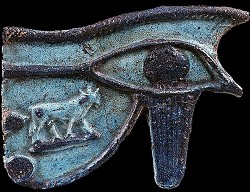
Eye of Horus, lost in the struggle with Seth. With the help of Hathor, Thoth or other gods, depending on the tradition, he later recovered his eye sound and well. Thus it was also called the udjat-eye (udjat = intact, complete, healthy). This eye became the symbol for everything to do with completion and healing, but was also involved in protection, perfection and power. As a result, the udjat-eye is one of the most common amulets, an apotropaic symbol protecting against the evil eye, and in a wider sense against all imaginable dangers. As an independently functioning being, the eye could be partly personified and given arms or wings. As far as its external appearance is concerned, the udjat-eye is a hybrid. The shape and the eyebrow derive from a human eye, while the lines underneath correspond to the markings of a falcon's eye. As the Eye of Horus it was originally the lunar eye, or the left eye of the sky god, but most amulets depict the right eye, originally the solar eye of Re. This was partly due to the Egyptians' association of right with good and positive things. Further, the sun much more than the moon is the symbol of the actual victory. This eye is added to stelae and particularly sarcophagi, in or above a depiction of a false door orientated towards the east. According to texts, this eye was meant to give the deceased the possibility to look out towards the rising sun. Such eyes are thus a later elaboration of the small holes which in the Old Kingdom allowed statues to look out of the serdab. Nevertheless, the protective aspect also plays a role. The udjat eye was sometimes added to doors, and the Pyramid Texts of the Old Kingdom mention a door bolt of two eyes.